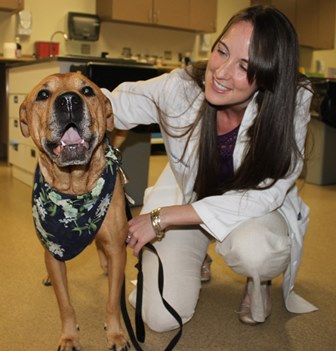Study: Gold-based drug may help fight bone cancer
in pets and people
By Sarah Carey
A gold-based drug currently used in human and veterinary medicine to manage certain immune diseases may prove useful in combating osteosarcoma, a devastating bone cancer that affects both dogs and people, University of Florida veterinary researchers report.
By examining an aggressive bone cell line in both species, the researchers found that the drug, aurothiomalate, commonly known as gold salts, kept cancer cells from forming in the laboratory.
“We also were able to demonstrate that the drug slows tumor growth and decreases metastasis when canine bone tumors were created in a mouse model,” said Valery Scharf, D.V.M, the study’s lead author. A small animal surgery resident at UF, Scharf completed her master’s degree last year. The research was the focus of her thesis.
The findings appear in the March 2014 issue of Anti-Cancer Drugs.
“This study shows that there is potential promise for the role of gold drugs as a part of bone cancer treatment in dogs and potentially in people, although more studies are needed before we can use them in a clinical setting,” Scharf said.
Osteosarcoma is the most common primary bone tumor of dogs and accounts for the vast majority of cancerous tumors — around 80 percent — in the canine skeleton. The condition occurs most commonly in large breed dogs that are middle-aged and older. Frequently, the cancer appears in the front leg, but it can occur in any bone, veterinarians say. Dogs with osteosarcoma often show signs of lameness in the affected leg.
Veterinarians typically amputate the affected limb to remove the primary tumor. Dogs can also receive chemotherapy if the cancer has spread beyond the primary tumor. However, some dogs aren’t candidates for amputation, and the decision to amputate can be difficult for pet owners as well.
In people, osteosarcoma is rare and also affects the long bones of the body. It typically is diagnosed in people under 25 years of age.
“Osteosarcoma is a frustrating disease, as you can treat the local tumor, but the metastasis is something there is no effective means of preventing,” Scharf said.
The use of gold compounds in human medicine has traditionally been based on gold’s ability to affect the body’s immune response and anti-inflammatory properties, with the primary use being the management of rheumatoid arthritis. In veterinary medicine, gold-based drugs are most commonly used to treat various autoimmune disorders. In recent years, however, aurothiomalate has been investigated for its potential effects against certain types of cancer.
The UF study is the first to focus on the drug’s effectiveness as a tool for possible canine bone cancer treatment.
In their study, the researchers first tested aurothiomalate on human and canine osteosarcoma cell lines in petri dishes, determining that aurothiomalate treatment decreased the formation of cancer cell colonies. The researchers then administered aurothiomalate or a placebo to 54 mice that had been injected with canine osteosarcoma cells. They then compared cell survival, tumor growth, metastasis, and other characteristics between groups.
They found that low doses of the drug significantly reduced cancer spread to the lungs — the site that osteosarcoma most frequently travels to in dogs. High doses reduced microscopic spread to the lungs and the incidence of tumor cell clusters within blood vessels.
Further study is needed to better understand the way in which aurothiomalate works against osteosarcoma cancer cells, and to better determine effective dose ranges before extending this research to dogs, the researchers said.
“One of the interesting things to me in studying oncology and our pets is that their disease often translates to human disease as well,” Scharf said. “Therefore, research on the animal side can potentially translate to human medicine as well.”
In addition to Scharf’s mentors, James Farese, D.V.M., and Rowan Milner, BVSc., Ph.D., and, study collaborators included Jeffrey Abbott, D.V.M., Ph.D., Julia Conway, D.V.M., Shannon Roff, D.V.M., and Dietmar Siemann, Ph.D., all from UF. Matti Kiupel, D.V.M., Ph.D., of Michigan State University, also collaborated on the study.












